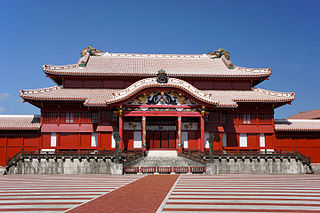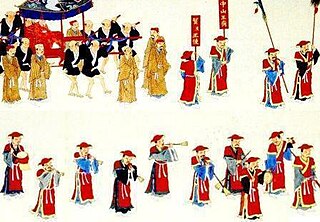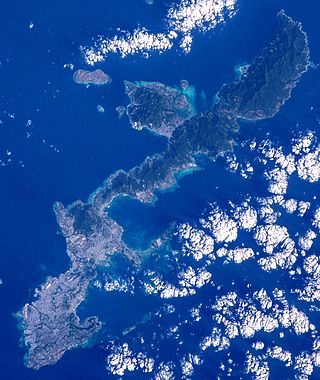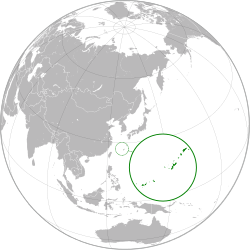
The Ryukyuan people are a Ryukyuan-speaking East Asian ethnic group native to the Ryukyu Islands, which stretch between the islands of Kyushu and Taiwan. Administratively, they live in either the Okinawa Prefecture or the Kagoshima Prefecture within Japan. They speak one of the Ryukyuan languages, considered to be one of the two branches of the Japonic language family, the other being Japanese and its dialects.

This article is about the history of the Ryukyu Islands southwest of the main islands of Japan.

The Ryukyu Kingdom was a kingdom in the Ryukyu Islands from 1429 to 1879. It was ruled as a tributary state of imperial Ming China by the Ryukyuan monarchy, who unified Okinawa Island to end the Sanzan period, and extended the kingdom to the Amami Islands and Sakishima Islands. The Ryukyu Kingdom played a central role in the maritime trade networks of medieval East Asia and Southeast Asia despite its small size. The Ryukyu Kingdom became a vassal state of the Satsuma Domain of Japan after the invasion of Ryukyu in 1609 but retained de jure independence until it was transformed into the Ryukyu Domain by the Empire of Japan in 1872. The Ryukyu Kingdom was formally annexed and dissolved by Japan in 1879 to form Okinawa Prefecture, and the Ryukyuan monarchy was integrated into the new Japanese nobility.

The Amami Islands is an archipelago in the Satsunan Islands, which is part of the Ryukyu Islands, and is southwest of Kyushu. Administratively, the group belongs to Kagoshima Prefecture, Japan. The Geospatial Information Authority of Japan and the Japan Coast Guard agreed on February 15, 2010, to use the name of Amami-guntō (奄美群島) for the Amami Islands. Prior to that, Amami-shotō (奄美諸島) was also used. The name of Amami is probably cognate with Amamikyu (阿摩美久), the goddess of creation in the Ryukyuan creation myth.

The Ryukyu independence movement or the Republic of the Ryukyus is a political movement advocating for the independence of the Ryukyu Islands from Japan.

The Ryukyu Islands, also known as the Nansei Islands or the Ryukyu Arc, are a chain of Japanese islands that stretch southwest from Kyushu to Taiwan: the Ōsumi, Tokara, Amami, Okinawa, and Sakishima Islands, with Yonaguni the westernmost. The larger are mostly volcanic islands and the smaller mostly coral. The largest is Okinawa Island.
Bunei was King of Chūzan. He was the second and last ruler of the Satto dynasty.
Satto (察度) was King of Chūzan. He is the first ruler of Okinawa Island who was recorded by contemporary sources. His reign was marked by expansion and development of Chūzan's trade relations with other states, and the beginning of Okinawa's tributary relations with Ming dynasty China, a relationship that continued for roughly five hundred years, almost until the fall of the Qing dynasty.

Chūzan (中山) was one of three kingdoms which controlled Okinawa in the 14th century. Okinawa, previously controlled by a number of local chieftains or lords, loosely bound by a paramount chieftain or king of the entire island, split into these three more solidly defined kingdoms within a few years after 1314; the Sanzan period thus began, and would end roughly one hundred years later, when Chūzan's King Shō Hashi conquered Hokuzan in 1419 and Nanzan in 1429.

Over the course of Japan's Edo period, the Ryūkyū Kingdom sent eighteen missions to Edo, the capital of Tokugawa Japan. The unique pattern of these diplomatic exchanges evolved from models established by the Chinese, but without denoting any predetermined relationship to China or to the Chinese world order. The Kingdom became a vassal to the Japanese feudal domain (han) of Satsuma following Satsuma's 1609 invasion of Ryūkyū, and as such were expected to pay tribute to the shogunate; the missions also served as a great source of prestige for Satsuma, the only han to claim any foreign polity, let alone a kingdom, as its vassal.
Shō Shitsu was a king of the Ryukyu Kingdom who held the throne from 1648 until his death in 1668.

King of Ryūkyū, also known as King of Lew Chew, King of Chūzan, or more officially Ryūkyū Kingdom's King of Chūzan, was a title held by several lineages from Okinawa Island until 1879. It effectively started in 1372 when Satto greeted a Chinese envoy from the newly established Ming dynasty although his son Bunei was the first to be officially recognized as the King of Chūzan. However, the official Okinawan narrative traces the line of succession further back to the legendary ruler Shunten, who supposedly ascended to the throne in 1187. Another peculiar feature of the official Okinawan narrative is the notion of the single line of succession, instead of Chinese-style dynastic changes, even though they clearly recognized that several unrelated lineages had taken over the position.
Imperial Chinese missions to the Ryukyu Kingdom were diplomatic missions that were intermittently sent by the Yuan, Ming and Qing emperors to Shuri, Okinawa, in the Ryukyu Islands. These diplomatic contacts were within the Sinocentric system of bilateral and multinational relationships in the Sinosphere.
Shishō, or Shō Shishō (尚思紹) in later sources, was Anji of Sashiki and later King of Chūzan, one of three polities on the island of Okinawa, before they were united. He was the progenitor of what became the First Shō dynasty.
Ryukyuan missions to Imperial China were diplomatic missions that were intermittently sent from the Ryukyuan kings to the Ming and Qing emperors. These diplomatic contacts were within the Sinocentric system of bilateral and multinational relationships in East Asia. A total of 347 Ryukyuan missions to China have been recorded.
Joseon missions to the Ryukyu Kingdom were diplomatic and trade ventures of the Joseon dynasty that were intermittently sent after 1392. These diplomatic contacts were within the Sinocentric system of bilateral and multinational relationships in East Asia. The Ryukyuan King Satto established formal relations with the Joseon court.

The Ryukyuan mon was the currency used in the Ryukyu Islands. The Ryukyuan monetary system was based on that of China, like those of many nations in the Sinosphere, with the mon serving as the basic unit, just as with the Japanese mon, Vietnamese văn, and Korean mun. Like Japan had also done for centuries, the Ryukyuans often made use of the already-existing Chinese cash coins when physical currency was needed.

The Ryukyu Disposition, also called the Ryukyu Annexation or the annexation of Okinawa, was the political process during the early years of the Meiji period that saw the incorporation of the former Ryukyu Kingdom into the Empire of Japan as Okinawa Prefecture and its decoupling from the Chinese tributary system. These processes began with the creation of Ryukyu Domain in 1872 and culminated in the kingdom's annexation and final dissolution in 1879; immediate diplomatic fallout and consequent negotiations with Qing China, brokered by Ulysses S. Grant, effectively came to an end late the following year. The term is also sometimes used more narrowly in relation to the events and changes of 1879 alone. The Ryūkyū Disposition has been "alternatively characterized as aggression, annexation, national unification, or internal reform".

Okinawa (沖縄) is a name with multiple referents. The endonym refers to Okinawa Island in southwestern Japan. Today it can cover some surrounding islands and, more importantly, can refer to Okinawa Prefecture, a much larger administrative division of Japan, although the people from the Miyako and Yaeyama Islands still feel a strong sense of otherness to Okinawa.

Ucinaasugai, also known as Ryusou and referred as ushinchi in Okinawan, is the traditional dress of the Ryukyuan people. Ryusou is a form of formal attire; it is customary to wear it on occasions such as wedding ceremony and the coming-of-age ceremony. The ryusou became popular during the Ryukyu Kingdom period. It was originally worn by the members of the royal family and by the nobles of Ryukyu Kingdom. The Ryukyu Kingdom was originally an independent nation which established trade relationship with many countries in Southeast Asia and East Asia; they held their relationship with China as especially important. The development of the ryusou was influenced by both the hanfu and the kimono, demonstrating a combination of Chinese and Japanese influences along with local originality.













